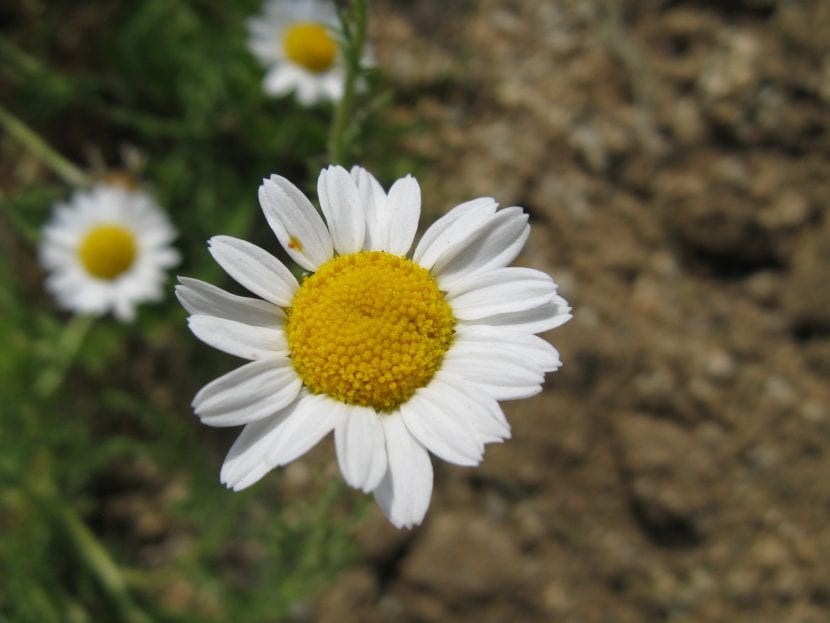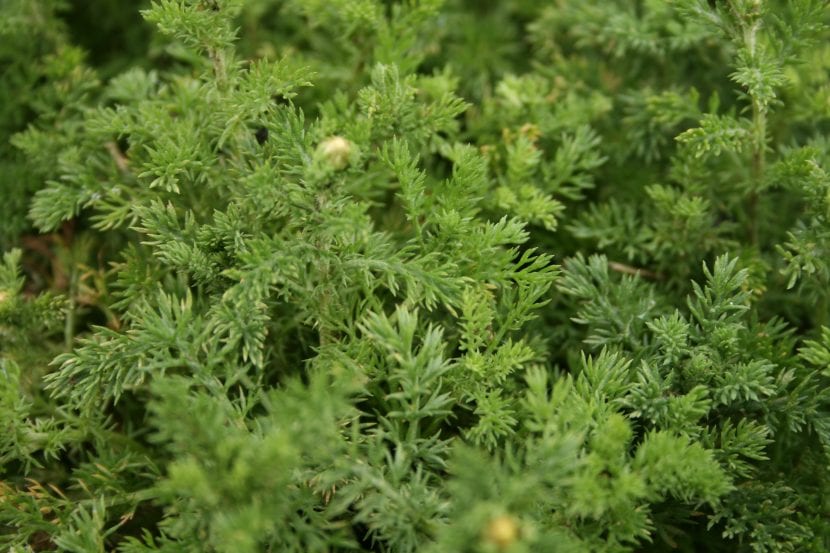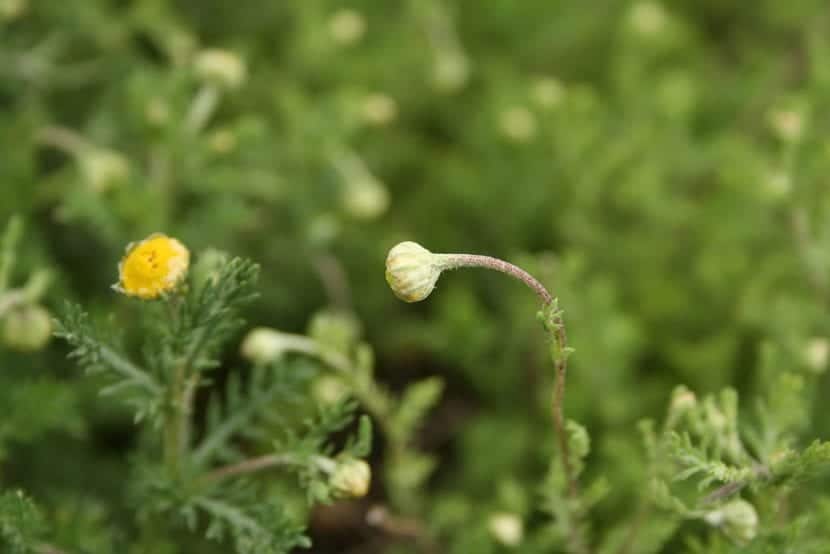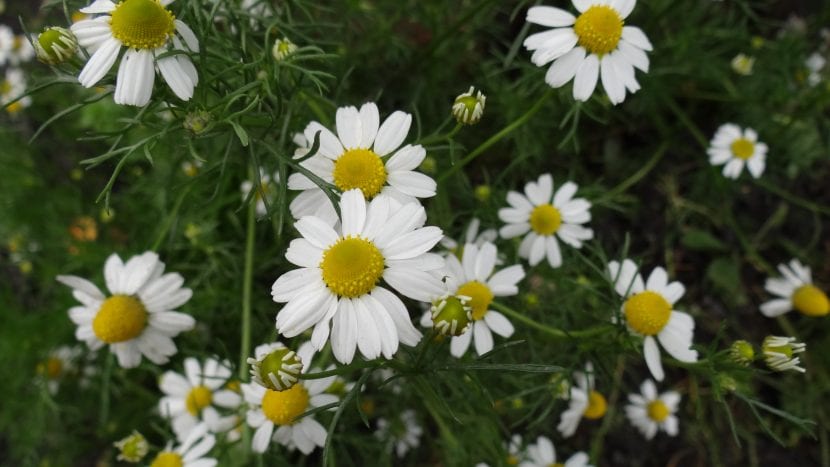
La chamomile, also known by the name of Roman chamomile, It is one of those plants that we have been growing for centuries. But that is a name that can create confusion, as it really is native to all of Western Europe, and can also be found in North Asia.
It is a very interesting plant, as it can be used as an ornamental, for the hair or as a medicinal, as we are going to tell you in this special that we have prepared for you.
Chamomile properties

Chamomile, whose scientific name is chamaemelum nobile, is a perennial herbaceous plant that grows up to 40cm in height and whose stems are very dense. The leaves are alternate, bi or tripinatilobed, with linear, dark green leaflets. The flowers appear during the summer, grouped in terminal panicle-shaped inflorescences. These have a yellow corolla and white petals.
It should be noted that it is a hermaphroditic herb, which means that can self-pollinate, but still, there are many insects that pollinate it, such as bees, wasps or bumblebees.
How is chamomile cared for?
Now that we know how to identify it every time we visit a garden, it is time to learn how to take care of it. Let's go there:
Location
We will place this beautiful plant outside, full sun. If we do not have such corners, we can have it in semi-shade, but it is important that it be a place where a lot of light arrives, even if it is indirect.
Irrigation
Irrigation has to be frecuente, especially during the hottest season. We will water about 3 times a week in summer, and every 4 days the rest of the year.
Soil or substrate
It is not demanding. If we choose to have it in the garden, it will be able to grow without problems even in limestone soils; and if, on the other hand, we want to have it in a pot, we can use universal cultivation substrate without problem.
Transplant

Whether we want to move it to the ground or change the pot, which by the way must be done every two years, we have to wait for spring to come.
Pruning
As the flowers fade it is important that they are cutting so that the plant continues to look beautiful and, incidentally, to prevent it from being attacked by parasites or fungi.
Subscriber
During spring and summer it is advisable to pay with Organic fertilizers, for example with guano or algae extract, but you should not abuse the latter as it is very alkaline and could cause chlorosis in our chamomile.
Plagues and diseases
It is one of the most resistant plants; so much so that only two plagues are known: the trips and aphids. Both are greatly favored by the heat and dryness of the environment, but they will only attack if the chamomile is having a bad time, that is, if it has insufficient or excessive irrigation, or if it is suffering from thermal stress (temperatures higher than 40ºC can harm it) .
Thus, to avoid them, it is important to have the growing conditions well controlled, and to water, always avoiding leaving the substrate dry for many days in a row (more than 4 in summer, and more than 7 the rest of the year). And in case you already have, treat it with Neem oil, or cut the affected parts.
Reproduction of chamomile

How to get new copies? Very easy: put seeds in spring. Follow this Step by Step to obtain new chamomile seedlings:
- The first thing to do is, obviously, acquire the seeds. We will find them for sale in nurseries and in agricultural stores.
- Once at home, it is advisable - it is not essential - to put them in a glass of water for 24 hours. In this way we will know which ones have the best chance of germinating, which will be the ones that sink.
- The next day, we will proceed to prepare the seedbed, which can be pots, cork trays, milk or yogurt containers, or whatever we prefer as long as it has holes for water drainage. We will fill it with universal cultivation substrate, or with a specific one for seedbeds, and we will water it.
- Next, we will place a maximum of three seeds in each one if it is small (20cm in diameter or less), and up to 5 if it is between 20 and 40cm in diameter. We will separate them as much as we can so that they can grow and develop well.
- Then we cover them with a thin layer of substrate, just enough so that the wind doesn't blow them away.
- Finally, we water with a watering can or with a sprayer, and we put it in an area exposed to direct sun.
Will germinate very soon, in a maximum of two weeks, but before moving them to larger pots or to the garden, you have to wait until they measure at least 10cm, for which you won't have to wait long, you'll see 😉.
Uses of chamomile

Chamomile is used, not only as an ornamental, but also because it is tonic, digestive, antispasmodic, anti-inflammatory, and if it was not enough prevents peptic ulcers, which are those that form in the mucosa that lines the stomach or duodenum.
For this, they are used six flower heads for each cup of water, but before starting this treatment you should consult with your doctor.
Effects of chamomile on hair
In recent times, chamomile has become very fashionable due to the effects it has on hair. But it must be taken into account that, although it has been used naturally as a lightener for centuries, we currently have shampoos that contain hydrogen peroxide. This is in a low concentration, between 3 and 9%, but it is high enough so that, together with the plant, you can obtain a lighter blonde color than what you already have.
Indeed, You will only notice its effects if your hair is light blonde and you want it to be even lighter; but not if it is dark blonde or brown.
Are these shampoos dangerous?
Dangerous as such it is not, but you have to know that hydrogen peroxide carries, as its name suggests, oxygen, and that it little by little oxidizes the hair, being able to leave it brittle.
And so far the chamomile special. What do you think? 🙂
I have loved your articles Monica, I will follow your advice, thank you very much !!
I'm glad you liked them, and thanks to you 🙂